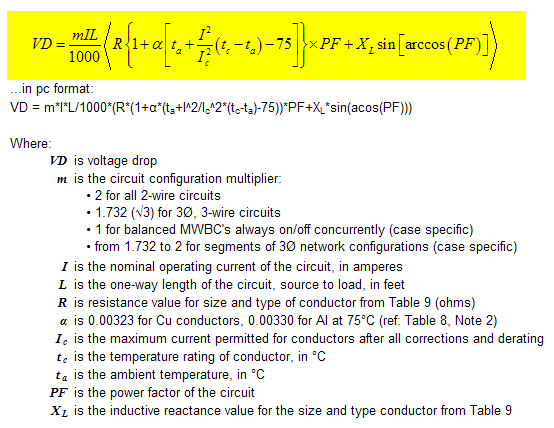My colleague and I thought we would point out a concern we have with the two different methods of doing a voltage drop calculation and see if the forum would agree with us:
Method I, VD=(2KXLXI)/Cm, where K is a constant based on conductor property and temperature in the cable; L is length one-way; I is current; cm is cross sectional area. Note that no power factor is assumed in this equation-this is a little upsetting to us.
Method II, VD=vXIXRcos(theta) + Xsin(theta), where theta is the power factor:R is resistance of the cable:X is reactance of the cable. Here there is no concern for the K value of the cable.
We compared our calculated result using equation method I against the voltage drop tables and found a significant result that we feel could lead to a different cable size selection based on the value selected for voltage drop. We know the voltage drop tables must have been derived using a computer program that uses one of the two methods to calculate voltage drop.
My colleagues" concern is that it is imperative that the right wire size is selected in the end obviously should loads be used that are not suited for the selected wire size.
Method I, VD=(2KXLXI)/Cm, where K is a constant based on conductor property and temperature in the cable; L is length one-way; I is current; cm is cross sectional area. Note that no power factor is assumed in this equation-this is a little upsetting to us.
Method II, VD=vXIXRcos(theta) + Xsin(theta), where theta is the power factor:R is resistance of the cable:X is reactance of the cable. Here there is no concern for the K value of the cable.
We compared our calculated result using equation method I against the voltage drop tables and found a significant result that we feel could lead to a different cable size selection based on the value selected for voltage drop. We know the voltage drop tables must have been derived using a computer program that uses one of the two methods to calculate voltage drop.
My colleagues" concern is that it is imperative that the right wire size is selected in the end obviously should loads be used that are not suited for the selected wire size.


